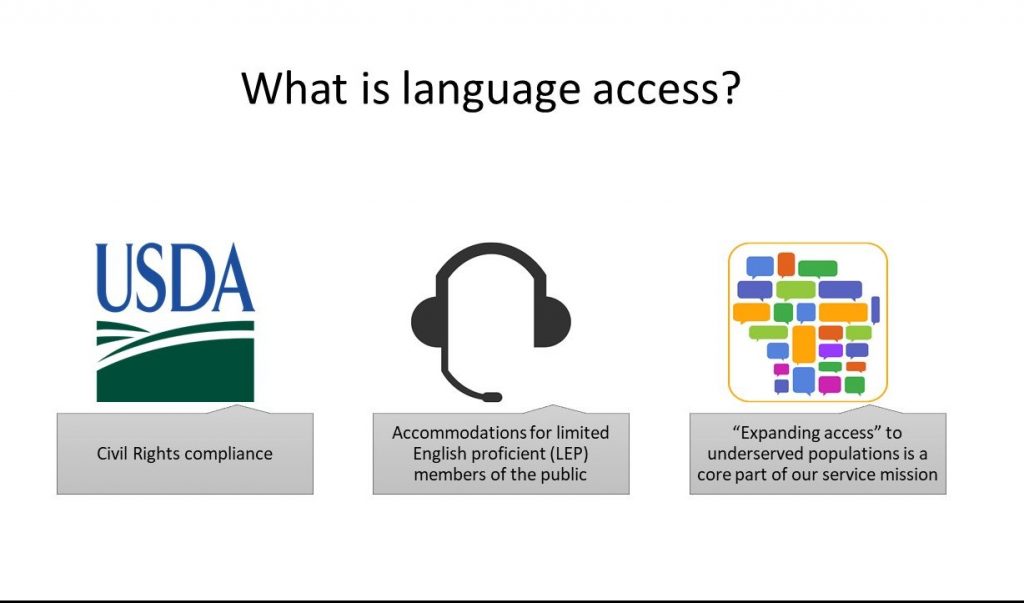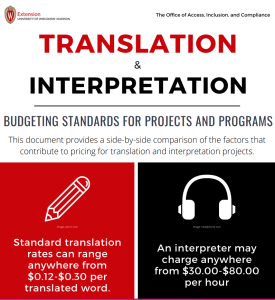What is language access graphic
The following sections answers frequently asked questions that have been asked to the Language Access team. Click the topic name to drag the screen to the topic area.
About Language Access
What is Language Access?
Extension defines “language access” as the strategic and systematic management of multilingual communication within different contexts and across various scales of delivery. With regard to Extension activities, language access has two main implications. First, language access involves the provision of appropriate accommodations (e.g. translation and interpretation) to mitigate communication barriers caused by language differences. Second, language access refers to Extension’s collective effort to create programming, services, and activities that are culturally responsive and linguistically appropriate for persons with limited English proficiency (LEP). The purpose of creating language access is to ensure equal footing and equitable participation in programs and activities for LEP persons and audiences.
Who are persons with limited English proficiency (LEP)?
What are our organizational obligations for serving LEP audiences?
- Provide free language support services for LEP audiences
- Provide public notice of language support services
- Maintain records of efforts to identify and serve LEP audiences
- Language access training
- Monitor and evaluate language support services
- Expand programming access to underserved populations
For additional information, consult our Language Access Plan.2017 (forthcoming)
Who is responsible for ensuring language access?
Our Language Access Policy
For specific deadlines and details about our process, our team has implemented a policy for colleagues to follow when they are submitting a request. You can find our policy at this link in the Extension Employee Handbook: https://kb.wisc.edu/extension/107803.
About our services
What services does the language access team provide?
- Translation Project Management
- Interpretation Project Management
- Coaching & Consultation
- Simultaneous Equipment Loan & Rental Program
- Fill out the online OAIC Support Request Form (online OSR)
- For emergency assistance or general questions, please contact the Office of Access, Inclusion, and Compliance at oaic@extension.wisc.edu
Does the Language Access Team also help address accommodations for the Deaf or Hard of Hearing?
The Americans with Disabilities Act (ADA) protects the rights of individuals who are deaf or hard of hearing, which is separate from Title VI compliance responsibilities for serving LEP populations.) Heather Stelljes (heather.stelljes@wisc.edu) is our coordinator for ADA-specific accommodation requests. The Language Access Team is committed to working collaboratively with the OEDI so as to ensure the seamless response to any request for language accommodations, regardless of the protected audience or type of barrier.
How does our Extension office start a conversation about serving LEP persons?
Ensuring quality in our services
Professional translator/interpreter profile: Language competence vs. translation competence
Professional translator/interpreter profile: Industry standards for qualifications and credentials
- Native or near native language proficiency in all languages of service delivery.
- Demonstrated professional experience working as a translator and/or interpreter.
- Relevant credentials that reflect educational/professional orientation in the delivery of language support services.
- Accredited translator/interpreter certification programs (State and Federal Courts, National Council on Interpreting in Healthcare, American Translator’s Association, etc.).
- Preparatory courses or translator/interpreter training programs administered through technical and community colleges.
- Educational degrees in the area of translation, interpretation, linguistics, language study.
What if we know of or have worked with professional interpreters in our local area?
The use of web-based translators
Costs for language access
Do I need funding to request language access services?
Requesting language access services does not require prior funding. Cost should never be a deterrent to requesting language access services. Creating a budget for language access services helps support the language access team in costs, however, the language access team has a central fund to support colleagues across the state.
How much does it cost to request language access services?
The cost for language access services varies per project. The cost varies for type of project, size of project, due date for the project, and more. You can find more information in the following infographics.
D003. Budgeting your translation or interpretation project
This document provides a brief overview of what to budget for translation and interpretation projects.
Estimating the cost of Language Access services
This document provides an estimation of costs for different language access services. It’s purpose is to help Extension
colleagues budget for Extension projects and/or programming. All costs are based on the current market rate. Typically when
documents are being translated into another language, there is an expansion factor of an additional 15 percent in cost.






